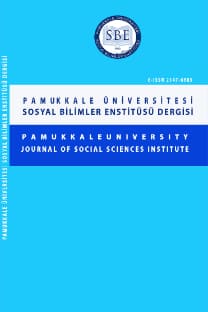PERFORMANS DEĞERLENDİRME HATALARINA İLİŞKİN ALGININ ÇALIŞAN SESSİZLİĞİ ÜZERİNDEKİ ETKİSİ
PERFORMANS DEĞERLENDİRME HATALARI, ÇALIŞAN SESSİZLİĞİ, ÇALIŞAN SESLİLİĞİ
THE EFFECT OF PERCEPTION OF PERFORMANCE APPRAISAL ERRORS ON EMPLOYEE SILENCE
Performance Appraisal Errors, employee silence, employee voice,
___
- Brinsfiels, C., Edwards, M. S. ve Greenberg, J. (2009). Voice and Silence in Organizations: Historical Review and Current Conceptualizations. UK: Emerald Group Publishing Limited.
- Çakıcı, A. (2007). Örgütlerde Sessizlik: Sessizliğin Teorik Temelleri ve Dinamikleri. Ç.Ü. Sosyal Bilimler Enstitüsü Dergisi, 16 (1), 145-162.
- Çetin, Ş. ve Çakmakçı, C. (2012). Çalışan Sesliliği Ölçeğini Türkçeye Uyarlama Çalışması. KHO Bilim Dergisi, 22 (2), 1-19.
- Erbasi, A., Arat, T. ve Buyukipekci, S. (2012). The Effect of Performance Appraisal Errors on Employee Performances: An Examination in Industrial Cooling Managements in Turkey in Terms of Employee Perceptions. European Scientific Journal, 8 (19), 1-23.
- Erbaşı, A. (2011). Performans Esaslı Bütçeleme Sisteminde Balanced Scorecard Kullanımı ve Bir Model Yaklaşımı. Doktora Tezi, Selçuk Üniversitesi Sosyal Bilimler Enstitüsü, Konya.
- Erbaşı, A. (2019). Performans Değerlendirme Hatalarının Çalışanların İşten Ayrılma Niyetleri ve Yöneticilerine Güvenleri Üzerindeki Etkisi. Uluslararası Yönetim İktisat ve İşletme Dergisi, 15 (1), 223-240.
- Etimoloji Türkçe (2019). https://www.etimolojiturkce.com/kelime/sound, Erişim Tarihi: 20.06.2019.
- Frazier, M. L. (2009). Voice Clımate in Organizations: A Group level Examination of Antecedents and Performance Outcomes. The Degree of Doctor of Philosophy, Oklahoma State University in partial fulfillment of the requirements, USA.
- Harvey, P., Martinko, M. J. ve Douglas, S. C. (2009). Voice and Silence in Organizations. UK: Emerald Group Publishing Limited.
- Hirschman, A. O. (1970). Exit, Voice and Loyalty: Responses to Decline in Firms, Organizations, and States. England: Harvard University Press.
- Jensen, V. (1973). Communicative Functions of Silence. ETC: A Review of General Semantics, 30 (3), 249-257.
- Kumari, S. (2012). A Study on Performance Appraisal Errors of Telecom Managers in Navi Mumbai Region. SIES Journal of Management, 8 (2), 1-12.
- Malik, R. ve Chikkara, S. (2018). Study of Performance Appraisal Systems in Service Industry in India. Journal of General Management Research, 5 (2), 55-69.
- Milliken, F. J., Morrison, E. W. ve Hewlin, P. F. (2003). An Exploratory Study of Employee Silence: Issues that Employees Don’t Communicate Upward and Why. Journal of Management Studies, 40 (6), 1453- 1476).
- Morrison, E. W. (2011). Employee Voice Behavior: Integration and Directions for Future Research. The Academy of Management Annals, 5 (1), 373-412.
- Morrison, E. W. ve Milliken, F. J. (2000). Organizational Silence: A Barrıer to Change and Development in A Pluralistic World. Academy of Management Review, 25 (4), 706-725.
- Morrison, E. W., Wheeler-Smith, S. ve Kamdar, D. (2011). Speaking Up in Groups: A Cross-Level Study of Group Voice Climate and Voice. Journal of Applied Psychology. 96 (1), 183-191.
- O’Donnell, J. (1990). The Effect of Performance Appraisal Purpose Training on Rating Errors and Accuracy. Human Resource Development Quartetly, 1 (2), 167-177.
- Pinder Craig C. ve Harlos, Karen P. (2001) “Employee Silence: Quiescence and Acquiescence as Responses to Perceived Injustice”, Research in Personnel and Human Resources Management, Volume 20, (331– 369).
- Sabuncuoğlu, Z. (2011). İnsan Kaynakları Yönetimi. İstanbul: Beta Basım Yayın.
- Tayfun, A. ve Çatır, O. (2013). Örgütsel Sessizlik ve Çalışanların Performansları Arasındaki İlişki Üzerine Bir Araştırma. İşletme Araştırmaları Dergisi, 5 (3), 114-134.
- TDK (2020).
- http://www.tdk.gov.tr/index.php?option=com_gts&arama=gts&guid=TDK.GTS.5cab2c5298be81.29229814, Erişim Tarihi: 24.06.2019.
- Tunçer, P. (2013). Örgütlerde Performans Değerlendirme ve Motivasyon. Sayıştay Dergisi, 88, 87-108. Van Dyne, L., Ang, S. ve Botero, I. C. (2003). Conceptualizing Employee Silence and Employee Voice as Multidimensional Constructs. Journal of Management Studies, 40 (6), 1359-1392.
- Van Dyne, L. ve LePine, J. (1998). Helping and Voice Extra-Role Behaviors: Evidence of Construct and Predictive Validity. Academy of Management Journal, 40 (1), 108-119.
- ISSN: 1308-2922
- Yayın Aralığı: 6
- Başlangıç: 2008
- Yayıncı: Pamukkale Üniversitesi
İŞ BİLİŞ ENVANTERİ ÖLÇEĞİ: BİR ÖLÇEK UYARLAMASI ÇALIŞMASI
Büşra MÜCELDİLİ, Berivan TATAR, Oya ERDİL
TÜRKİYE’DE PROTEİN İÇERİKLİ ÜRÜNLERE YÖNELİK TALEP TAHMİNİ: WORKINGLESER MODELİ
Dilek BAŞAR DİKMEN, Fatih Hakan DİKMEN
TERÖRLE MÜCADELEDE İSTİHBARATA BAŞVURU: AÇIK KAYNAK İSTİHBARATININ KULLANIMI
TÜRKİYE’DE YENİLENEBİLİR ENERJİ TÜKETİMİNİN EKONOMİK BÜYÜME VE SAĞLIK HARCAMALARI ÜZERİNDEKİ ETKİSİ
Aysun KARAMIKLI, Mahmut Ünsal ŞAŞMAZ
Z KUŞAĞININ İŞYERİ SEÇİMİNDE İŞVEREN MARKASININ ETKİSİ: OTEL İŞLETMELERİ ÖRNEĞİ
KLASİK TÜRK ŞİİRİNDE GALATALI ŞAİR SIYÂMÎ-İ RÛMÎ’NİN REDD-İ MATLA’ GAZELLERİ
ENFLASYON VE ENFLASYON BELİRSİZLİĞİ İLİŞKİSİNİN TÜRKİYE EKONOMİSİ AÇISINDAN ANALİZİ
